[English] 日本語
 Yorodumi
Yorodumi- PDB-6mgv: Structure of mechanically activated ion channel OSCA1.2 in nanodisc -
+ Open data
Open data
- Basic information
Basic information
| Entry | Database: PDB / ID: 6mgv | |||||||||
|---|---|---|---|---|---|---|---|---|---|---|
| Title | Structure of mechanically activated ion channel OSCA1.2 in nanodisc | |||||||||
 Components Components | Calcium permeable stress-gated cation channel 1 | |||||||||
 Keywords Keywords | MEMBRANE PROTEIN / Mechanically activated ion channel | |||||||||
| Function / homology |  Function and homology information Function and homology informationmechanosensitive monoatomic ion channel activity / calcium-activated cation channel activity / monoatomic cation transport / identical protein binding / plasma membrane Similarity search - Function | |||||||||
| Biological species |  | |||||||||
| Method | ELECTRON MICROSCOPY / single particle reconstruction / cryo EM / Resolution: 3.1 Å | |||||||||
 Authors Authors | Jojoa-Cruz, S. / Saotome, K. / Patapoutian, A. / Ward, A.B. | |||||||||
| Funding support |  United States, 2items United States, 2items
| |||||||||
 Citation Citation |  Journal: Elife / Year: 2018 Journal: Elife / Year: 2018Title: Cryo-EM structure of the mechanically activated ion channel OSCA1.2. Authors: Sebastian Jojoa-Cruz / Kei Saotome / Swetha E Murthy / Che Chun Alex Tsui / Mark Sp Sansom / Ardem Patapoutian / Andrew B Ward /   Abstract: Mechanically activated ion channels underlie touch, hearing, shear-stress sensing, and response to turgor pressure. OSCA/TMEM63s are a newly-identified family of eukaryotic mechanically activated ion ...Mechanically activated ion channels underlie touch, hearing, shear-stress sensing, and response to turgor pressure. OSCA/TMEM63s are a newly-identified family of eukaryotic mechanically activated ion channels opened by membrane tension. The structural underpinnings of OSCA/TMEM63 function are not explored. Here, we elucidate high resolution cryo-electron microscopy structures of OSCA1.2, revealing a dimeric architecture containing eleven transmembrane helices per subunit and surprising topological similarities to TMEM16 proteins. We locate the ion permeation pathway within each subunit by demonstrating that a conserved acidic residue is a determinant of channel conductance. Molecular dynamics simulations reveal membrane interactions, suggesting the role of lipids in OSCA1.2 gating. These results lay a foundation to decipher how the structural organization of OSCA/TMEM63 is suited for their roles as MA ion channels. | |||||||||
| History |
|
- Structure visualization
Structure visualization
| Movie |
 Movie viewer Movie viewer |
|---|---|
| Structure viewer | Molecule:  Molmil Molmil Jmol/JSmol Jmol/JSmol |
- Downloads & links
Downloads & links
- Download
Download
| PDBx/mmCIF format |  6mgv.cif.gz 6mgv.cif.gz | 256.8 KB | Display |  PDBx/mmCIF format PDBx/mmCIF format |
|---|---|---|---|---|
| PDB format |  pdb6mgv.ent.gz pdb6mgv.ent.gz | 204.8 KB | Display |  PDB format PDB format |
| PDBx/mmJSON format |  6mgv.json.gz 6mgv.json.gz | Tree view |  PDBx/mmJSON format PDBx/mmJSON format | |
| Others |  Other downloads Other downloads |
-Validation report
| Summary document |  6mgv_validation.pdf.gz 6mgv_validation.pdf.gz | 1.2 MB | Display |  wwPDB validaton report wwPDB validaton report |
|---|---|---|---|---|
| Full document |  6mgv_full_validation.pdf.gz 6mgv_full_validation.pdf.gz | 1.2 MB | Display | |
| Data in XML |  6mgv_validation.xml.gz 6mgv_validation.xml.gz | 42.8 KB | Display | |
| Data in CIF |  6mgv_validation.cif.gz 6mgv_validation.cif.gz | 66.3 KB | Display | |
| Arichive directory |  https://data.pdbj.org/pub/pdb/validation_reports/mg/6mgv https://data.pdbj.org/pub/pdb/validation_reports/mg/6mgv ftp://data.pdbj.org/pub/pdb/validation_reports/mg/6mgv ftp://data.pdbj.org/pub/pdb/validation_reports/mg/6mgv | HTTPS FTP |
-Related structure data
| Related structure data |  9112MC  9113C  6mgwC M: map data used to model this data C: citing same article ( |
|---|---|
| Similar structure data |
- Links
Links
- Assembly
Assembly
| Deposited unit | 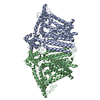
|
|---|---|
| 1 |
|
- Components
Components
| #1: Protein | Mass: 89031.719 Da / Num. of mol.: 2 Source method: isolated from a genetically manipulated source Source: (gene. exp.)   Homo sapiens (human) / References: UniProt: Q5XEZ5 Homo sapiens (human) / References: UniProt: Q5XEZ5 |
|---|
-Experimental details
-Experiment
| Experiment | Method: ELECTRON MICROSCOPY |
|---|---|
| EM experiment | Aggregation state: PARTICLE / 3D reconstruction method: single particle reconstruction |
- Sample preparation
Sample preparation
| Component | Name: OSCA1.2 / Type: ORGANELLE OR CELLULAR COMPONENT / Entity ID: all / Source: RECOMBINANT |
|---|---|
| Molecular weight | Value: 0.088 MDa / Experimental value: NO |
| Source (natural) | Organism:  |
| Source (recombinant) | Organism:  Homo sapiens (human) / Cell: HEK293F / Plasmid: pcDNA3.1 Homo sapiens (human) / Cell: HEK293F / Plasmid: pcDNA3.1 |
| Buffer solution | pH: 8 |
| Specimen | Conc.: 2.1 mg/ml / Embedding applied: NO / Shadowing applied: NO / Staining applied: NO / Vitrification applied: YES |
| Specimen support | Grid material: GOLD / Grid mesh size: 300 divisions/in. |
| Vitrification | Instrument: FEI VITROBOT MARK IV / Cryogen name: ETHANE |
- Electron microscopy imaging
Electron microscopy imaging
| Experimental equipment |  Model: Talos Arctica / Image courtesy: FEI Company |
|---|---|
| Microscopy | Model: FEI TALOS ARCTICA |
| Electron gun | Electron source:  FIELD EMISSION GUN / Accelerating voltage: 200 kV / Illumination mode: OTHER FIELD EMISSION GUN / Accelerating voltage: 200 kV / Illumination mode: OTHER |
| Electron lens | Mode: BRIGHT FIELD / Nominal magnification: 36000 X / Nominal defocus max: -2200 nm / Nominal defocus min: -400 nm / Cs: 2.7 mm / C2 aperture diameter: 70 µm |
| Image recording | Electron dose: 60 e/Å2 / Detector mode: COUNTING / Film or detector model: GATAN K2 SUMMIT (4k x 4k) / Num. of grids imaged: 1 / Num. of real images: 1740 |
| Image scans | Width: 3710 / Height: 3838 / Movie frames/image: 54 |
- Processing
Processing
| EM software |
| ||||||||||||||||||||||||||||||||
|---|---|---|---|---|---|---|---|---|---|---|---|---|---|---|---|---|---|---|---|---|---|---|---|---|---|---|---|---|---|---|---|---|---|
| CTF correction | Type: PHASE FLIPPING AND AMPLITUDE CORRECTION | ||||||||||||||||||||||||||||||||
| Particle selection | Num. of particles selected: 326398 | ||||||||||||||||||||||||||||||||
| Symmetry | Point symmetry: C2 (2 fold cyclic) | ||||||||||||||||||||||||||||||||
| 3D reconstruction | Resolution: 3.1 Å / Resolution method: FSC 0.143 CUT-OFF / Num. of particles: 76797 / Num. of class averages: 2 / Symmetry type: POINT |
 Movie
Movie Controller
Controller


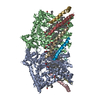
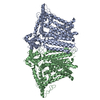

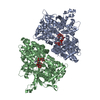


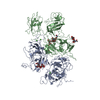
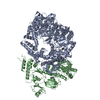
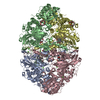
 PDBj
PDBj